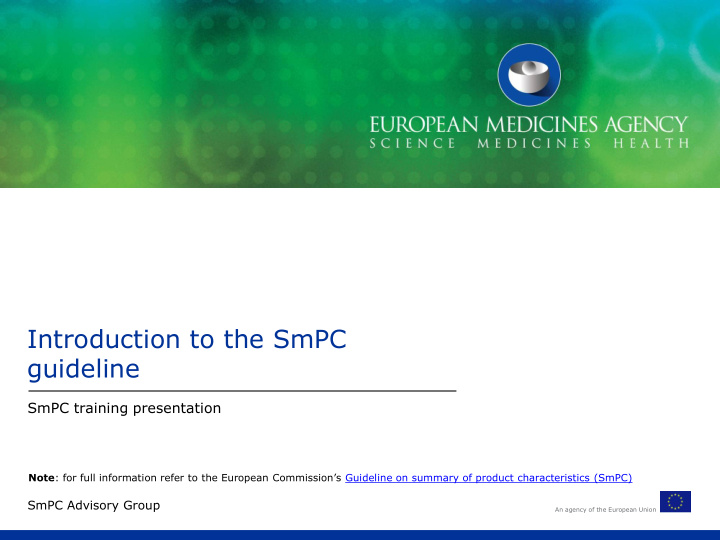



Introduction to the SmPC guideline SmPC training presentation Note : for full information refer to the European Commission’s Guideline on summary of product characteristics (SmPC) SmPC Advisory Group An agency of the European Union
Table of contents I. SmPC: The key reference document on a medicinal product II. SmPC: The cornerstone between assessment and information III. SmPC and SmPC guideline IV. Conclusion Annex: Summary of the scope of the 2009 update of the SmPC guideline 2 Introduction to the SmPC guideline
I. SmPC: the key reference document on a medicinal product • The SmPC is the basis of information on how to use the medicinal product safely and effectively • The SmPC forms an integral part of the marketing authorisation • The package leaflet shall be drawn up in accordance with the SmPC • All parts of the advertising of a medicinal product must comply with the particulars listed in the summary of product characteristics • A broad audience (…/…) “SmPCs are the definitive source of information on the licensed uses of a medicine” (Drug and Therapeutics Bulletin/Vol 47/No 5/May 2009) 3 Introduction to the SmPC guideline
SmPC: A broad use and audience The SmPC is the key reference document which provides information, directly or indirectly, on how to use the medicinal product safely and effectively Through: – Regulatory source of information (e.g. EMA, HMA or NCAs websites) – The package leaflet which shall be drawn up in accordance with the SmPC – National compendium, Formulary – Electronic databases of information on medicinal products – Marketing communication To: – Healthcare professionals, including Health Technology Assessment bodies – Patients and consumers (organisations), public 4 Introduction to the SmPC guideline
II. SmPC: The cornerstone between assessment and information • The SmPC is the result of the agreed position on the medicinal product, as distilled during the course of the assessment process, before and after marketing authorisation • The scientific assessment should evaluate how the SmPC will optimise the benefits and manage the risks • Factors which may influence a benefit or a risk in an individual should be clearly described • The SmPC has to be updated throughout the life of the product as data emerge The holder of the marketing authorisation shall forthwith supply any new information which might entail the variation of the marketing authorisation including the SmPC (EC/726/2004) 5 Introduction to the SmPC guideline NC: non-clinical
III.SmPC and SmPC guideline For full information refer to the EC Guideline on the SmPC • Article 11 of Directive 2001/83/EC defines the content and the order of the SmPC • The SmPC guideline advises on the principles of presenting information in the SmPC – Product specific information – Clear and concise language (Public Assessment Report provides detailed information) – Advice for use in the core population for whom the medicine is indicated followed - when necessary – by specific information for any relevant special population 6 Introduction to the SmPC guideline
Some key principles of the SmPC guideline Section 4.1 should define unambiguously for whom the medicine is indicated specifying any limitation, e.g. age Section 4.2 should clearly specify the posology for each indication and relevant patient category for which the medicine is indicated, including any special population in which dose adjustment may be required Section 4.3 “Contraindications” should only include situations where the medicine must not be given Section 4.4 should present information on a specific risk only when the risk leads to a precaution for use or when healthcare professionals have to be warned of this risk Section 4.8 should summarise the safety profile of the medicine and list all adverse reactions (but not the adverse events) Section 4.5 should highlight the clinically relevant interactions which result in a recommendation for use Section 5.1 may provide limited information on clinical results if it is relevant to the prescriber, statistically compelling and supports the authorised indication(s) For detailed information on a medicinal product, reference should be made to the public assessment report within the SmPC (e.g. “ Detailed information on this product is available on the website of the European Medicines Agency (EMEA) http://www.ema.europa.eu”) 7 Introduction to the SmPC guideline
IV.Conclusion • The SmPC – Is a legal reference document – Is the basis for safe and effective use of a medicinal product – Should be clear, concise, evidence-based, relevant to healthcare professionals – Should be updated regularly when new information becomes available • The SmPC guideline advises on the principles of presenting information in the SmPC to ensure the provision of clear information on the benefits and the risks of a medicinal product. It also contributes to individualised treatment by informing on factors that may influence such benefits or risks 8 Introduction to the SmPC guideline
Annex: Summary of the scope of the 2009 update of the SmPC guideline • Enhanced guidance on the presentation of paediatric information • Clarification of guidance for sections 4.8 and 4.4 • Reinforcement of principles for presenting clear and concise information • Some other changes: – Guidance on the presentation of pharmacogenomic data – 2: excipients listed should be stated qualitatively and quantitatively – 4.2: divided into two subsections, “Posology” and “Method of administration” – 4.6: update according to CHMP/SWP guideline on human reproduction and lactation – 4.7: Distinction introduced between “minor influence” and “moderate influence” – 4.9: clearer recommendation for information on monitoring – 5.1: specific standard statement for biosimilar medicinal product – 5.3: Environmental Risk Assessment (ERA) – 6.1: “Authentication factor” 9 Introduction to the SmPC guideline
Thank you for consulting this training presentation SmPC Advisory Group
Recommend
More recommend